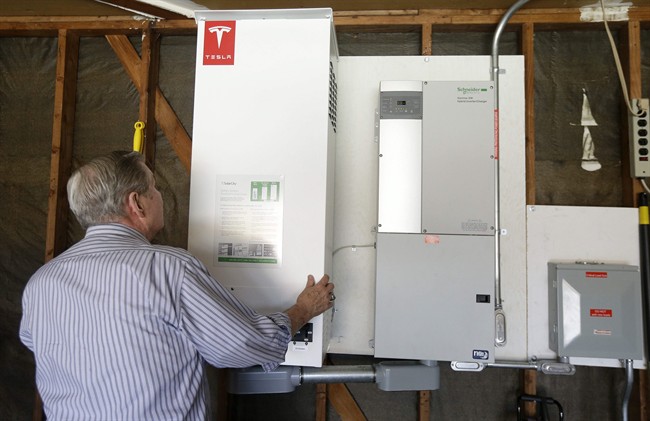TORONTO – In typical Elon Musk fashion, the announcement of Tesla’s new Powerwall home battery was released with much fanfare.

So here are a few questions the announcement leaves for consumers.
1. How affordable is it?
There are two models: a 10 kilowatt-hour (kWh) one (which Tesla says is for “backup applications”) and a 7 kWh one, considered to be for daily operations.
The 10 kWh model costs $3,500, while the 7 kWh model is $3,000. At first glance it may not seem like too much of an investment for those with solar energy, but that doesn’t include the cost of the AC-DC inverter which could cost around $4,000. It also doesn’t include the cost of installation. So one is likely looking at close to US$10,000.
READ MORE: Tesla is developing a battery to power your home
2. How is this different from other forms of batteries?
The idea of battery backup isn’t a new one.
Outback Power, for example, provides a similar product with its Radian Series.
“Tesla and Elon Musk are really following through on a number of things that really everybody knows about in the field. And they’re able to leverage their vast resources and entrepreneurial expertise to bring some of these things to the market,” said Stephen Harrison, associate professor in Mechanical and Materials Engineering at Queen’s University in Kingston, Ontario.
“It’s really that capability to move on these technologies that is the unique feature here.”
3. Will this save me money?
That question is a tougher one to answer.
According to Environmental Defence Canada, the average Ontario homeowner uses about 800 kWh a month in energy. This averages to roughly 25 kWh a day. But that varies on time of day and even time of year.
So, it’s not going to necessarily run the house, it will supplement it.
Harrison said that it also depends on a particular region and how their energy program works. For example, it would be most beneficial in a time-of-use billing, such as the one Ontario just introduced. For example, off-peak costs 8.0 cents per kWh, mid-peak 12.2 kWh, and on-peak 16.1 kWh. A homeowner could shift the load, ie. not loading in peak hours. Then you might save yourself some money.
“It has the potential to save them money if it uses time-of-use billing,” said Harrison. “You’d have to look at that jurisdiction and the rates to determine what it could save for you.”
4. What are the benefits?
One of the benefits to using Powerwall for those who use solar power is that it would serve as a good back-up system in the event of a power outage. Harrison said that there is a massive market for commercial users — think computer systems — where that security could mean a lot.
As mentioned above, it would also allow you to “time-shift” the load of energy.
5. Will it be available in Canada?
Unknown.
Tesla did not respond to requests from Global News at the time of publication.



Comments